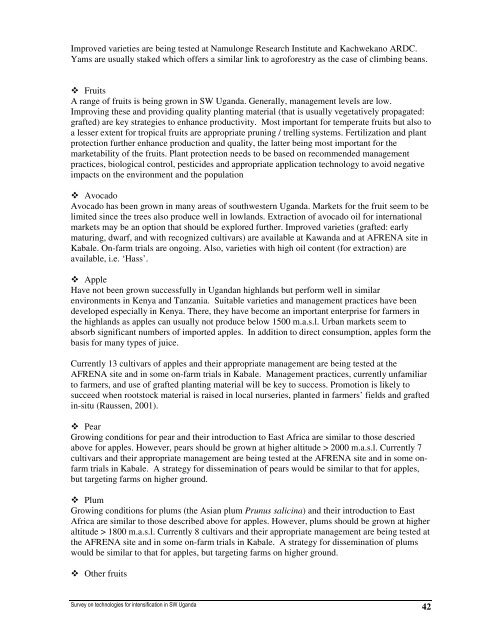Technologies for intensification in SW Uganda ... - Foodnet - cgiar
Technologies for intensification in SW Uganda ... - Foodnet - cgiar
Technologies for intensification in SW Uganda ... - Foodnet - cgiar
Create successful ePaper yourself
Turn your PDF publications into a flip-book with our unique Google optimized e-Paper software.
Improved varieties are be<strong>in</strong>g tested at Namulonge Research Institute and Kachwekano ARDC.<br />
Yams are usually staked which offers a similar l<strong>in</strong>k to agro<strong>for</strong>estry as the case of climb<strong>in</strong>g beans.<br />
Fruits<br />
A range of fruits is be<strong>in</strong>g grown <strong>in</strong> <strong>SW</strong> <strong>Uganda</strong>. Generally, management levels are low.<br />
Improv<strong>in</strong>g these and provid<strong>in</strong>g quality plant<strong>in</strong>g material (that is usually vegetatively propagated:<br />
grafted) are key strategies to enhance productivity. Most important <strong>for</strong> temperate fruits but also to<br />
a lesser extent <strong>for</strong> tropical fruits are appropriate prun<strong>in</strong>g / trell<strong>in</strong>g systems. Fertilization and plant<br />
protection further enhance production and quality, the latter be<strong>in</strong>g most important <strong>for</strong> the<br />
marketability of the fruits. Plant protection needs to be based on recommended management<br />
practices, biological control, pesticides and appropriate application technology to avoid negative<br />
impacts on the environment and the population<br />
Avocado<br />
Avocado has been grown <strong>in</strong> many areas of southwestern <strong>Uganda</strong>. Markets <strong>for</strong> the fruit seem to be<br />
limited s<strong>in</strong>ce the trees also produce well <strong>in</strong> lowlands. Extraction of avocado oil <strong>for</strong> <strong>in</strong>ternational<br />
markets may be an option that should be explored further. Improved varieties (grafted: early<br />
matur<strong>in</strong>g, dwarf, and with recognized cultivars) are available at Kawanda and at AFRENA site <strong>in</strong><br />
Kabale. On-farm trials are ongo<strong>in</strong>g. Also, varieties with high oil content (<strong>for</strong> extraction) are<br />
available, i.e. ‘Hass’.<br />
Apple<br />
Have not been grown successfully <strong>in</strong> <strong>Uganda</strong>n highlands but per<strong>for</strong>m well <strong>in</strong> similar<br />
environments <strong>in</strong> Kenya and Tanzania. Suitable varieties and management practices have been<br />
developed especially <strong>in</strong> Kenya. There, they have become an important enterprise <strong>for</strong> farmers <strong>in</strong><br />
the highlands as apples can usually not produce below 1500 m.a.s.l. Urban markets seem to<br />
absorb significant numbers of imported apples. In addition to direct consumption, apples <strong>for</strong>m the<br />
basis <strong>for</strong> many types of juice.<br />
Currently 13 cultivars of apples and their appropriate management are be<strong>in</strong>g tested at the<br />
AFRENA site and <strong>in</strong> some on-farm trials <strong>in</strong> Kabale. Management practices, currently unfamiliar<br />
to farmers, and use of grafted plant<strong>in</strong>g material will be key to success. Promotion is likely to<br />
succeed when rootstock material is raised <strong>in</strong> local nurseries, planted <strong>in</strong> farmers’ fields and grafted<br />
<strong>in</strong>-situ (Raussen, 2001).<br />
Pear<br />
Grow<strong>in</strong>g conditions <strong>for</strong> pear and their <strong>in</strong>troduction to East Africa are similar to those descried<br />
above <strong>for</strong> apples. However, pears should be grown at higher altitude > 2000 m.a.s.l. Currently 7<br />
cultivars and their appropriate management are be<strong>in</strong>g tested at the AFRENA site and <strong>in</strong> some onfarm<br />
trials <strong>in</strong> Kabale. A strategy <strong>for</strong> dissem<strong>in</strong>ation of pears would be similar to that <strong>for</strong> apples,<br />
but target<strong>in</strong>g farms on higher ground.<br />
Plum<br />
Grow<strong>in</strong>g conditions <strong>for</strong> plums (the Asian plum Prunus salic<strong>in</strong>a) and their <strong>in</strong>troduction to East<br />
Africa are similar to those described above <strong>for</strong> apples. However, plums should be grown at higher<br />
altitude > 1800 m.a.s.l. Currently 8 cultivars and their appropriate management are be<strong>in</strong>g tested at<br />
the AFRENA site and <strong>in</strong> some on-farm trials <strong>in</strong> Kabale. A strategy <strong>for</strong> dissem<strong>in</strong>ation of plums<br />
would be similar to that <strong>for</strong> apples, but target<strong>in</strong>g farms on higher ground.<br />
Other fruits<br />
42
















